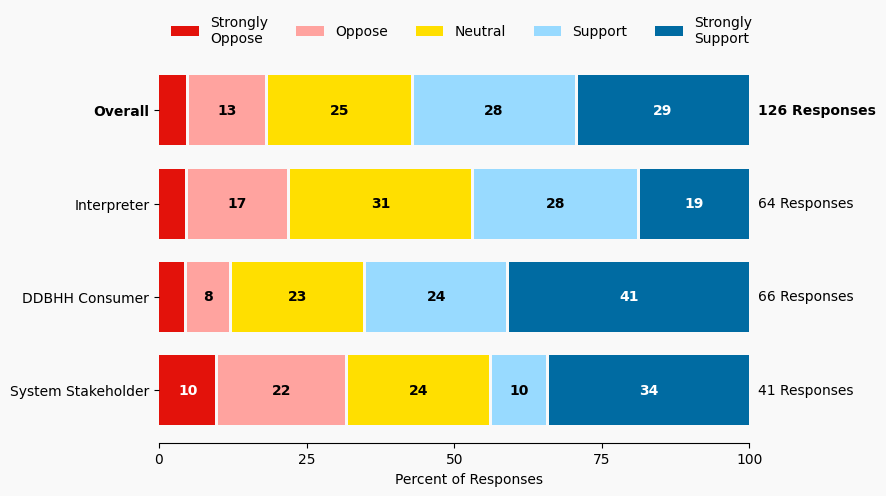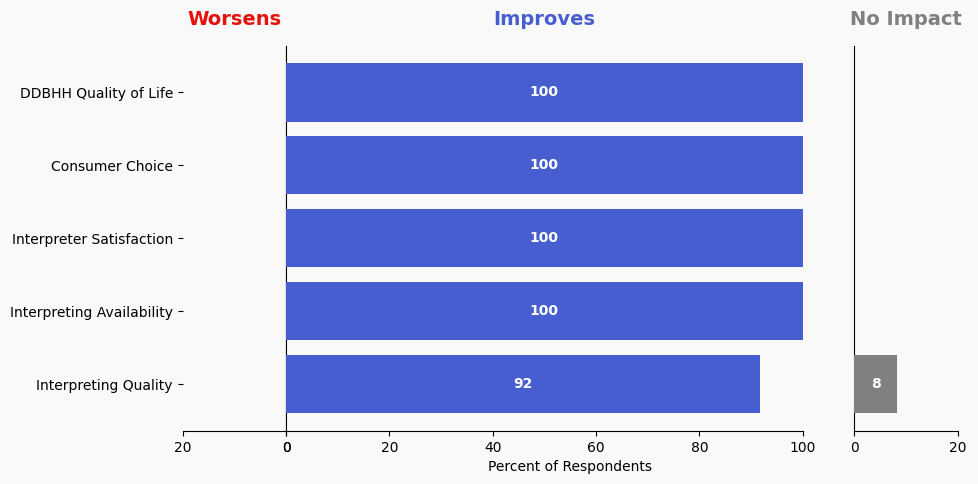15 Create a Central State Government Interpreting Services Office
Issue: Burden on individual state agencies for interpreting costs; no central state model of excellence in interpreting. With the One Minnesota campaign, the philosophy falls short and penalizes entities with DDBHH employees, as well as penalizes state agencies that have to pay for interpreting services.
Proposed Solution: Coalition research the state expenses of interpreting services and propose a centralized office of interpreting services for state government. Office would be funded by Minnesota Management and Budget and services would be available to all state entities. This could streamline use of resources as well as provide a neutral central office for coordination, setting standards, advice, internships and other initiatives.
Expected outcome: State constituents who are DDBHH know of the central office for receiving services. Multiple interpreters employed by the state.
Who is impacted: state agencies, DDBHH state employees, interpreters
Timeline: 6 months

Summary of Support Image Description
The stacked bar charts show how respondents rated their level of support and the total number of responses. The percentage for the five support levels is shown from left to right: Strongly Oppose (Dark Red), Oppose (Light Red), Neutral (Yellow), Support (Light Blue), and Strongly Support (Dark Blue).
Respondents may identify with multiple subgroups. The overall level of support is:
Overall
Strongly Oppose: 5%
Oppose: 13%
Neutral: 25%
Support: 28%
Strongly Support: 28%
Click to see the detailed image description for each subgroup.
Interpreter
Strongly Oppose: 5%
Oppose: 17%
Neutral: 31%
Support: 28%
Strongly Support: 19%
DDBHH Consumer
Strongly Oppose: 5%
Oppose: 8%
Neutral: 23%
Support: 24%
Strongly Support: 41%
System Stakeholder
Strongly Oppose: 10%
Oppose: 22%
Neutral: 24%
Support: 10%
Strongly Support: 34%
Overview of Respondents Opting for In-Depth Solution Analysis
After indicating their support level, 10% of the 126 respondents opted in to further assess whether the solution would worsen or improve on five metrics. Of the opt-in reviewers (13 respondents), 76% supported the solution, 7% were neutral on the solution, and 15% opposed the solution.
The remaining 113 respondents did not opt in to further assess the solution. Of these people, 54% support the solution, 26% were neutral on the solution, and 18% opposed the solution.
Reviewer Evaluation of Solution Effectiveness

Solution Effectiveness Image Description
The stacked bar charts show how respondents assessed the effectiveness of this solution based on five metrics. For each metric, the percentage of respondents is shown from left to right: Worsens (Red), Improves (Blue), No Impact (Gray).
DDBHH Quality of Life
Makes It Worse 0%
Makes It Better 100%
No Impact 0%
Interpreter Satisfaction
Makes It Worse 0%
Makes It Better 100%
No Impact 0%
Consumer Choice
Makes It Worse 0%
Makes It Better 100%
No Impact 0%
Interpreting Availability
Makes It Worse 0%
Makes It Better 100%
No Impact 0%
Interpreting Quality
Makes It Worse 0%
Makes It Better 91%
No Impact 8%
Reviewer Feedback and Insights
Interpreter
Comments from Interpreters express interest in the idea of a Central State Government Interpreting Services Office but seek more information about how it would function in practice. One comment suggests learning from other states if such models exist and emphasize the importance of involving Deaf professionals and interpreters in the process.
Deaf, DeafBlind, Hard of Hearing
One comment from DDBHH Consumers strongly support the idea, suggesting the University of Minnesota Interpreting Captioning Unit as a model and contrast this with the more challenging experience of working with the Legislative Coordinating Commission.
System Stakeholder
Comments from System stakeholders focus on the potential benefits of creating such an office, emphasizing the need for accountability, accessibility, and ficial efficiency. One comment stresses the importance of involving Deaf professionals and interpreters in the initiative.
PREVIOUS SOLUTION
14 Expand Deaf, DeafBlind and Hard of Hearing State Services Grants
Issue: There are multiple needs for interpreting supports to increase the quality and availability of interpreters, particularly in Greater Minnesota and for DeafBlind consumers.
NEXT SOLUTION
16 Recognize Less Frequent Specialty Areas of Interpreting
Issue: No widespread standards exist for some specialty areas of interpreting. Few specialty areas have assessments, credentialing or training programs. Interpreters can participate in the following training programs. Qualified Mental Health Interpreter Deaf Blind Interpreter ProTactile Language Interpreter NTID’s Master of Sciences in Health Care Interpretation NTID’s Certificate in Health Care Interpretation Interpreters can currently sit for the following specialist credentials. Texas’ Board of Evaluation of Interpreters Certification Program (BEI): Medical, Court, Trilingual (Spanish) Core Certification Healthcare Interpreter™ (CoreCHI™) certification is for any language, not specific to ASL. Educational Interpreter Performance Assessment (ASL English K12 educational assessment) RID formerly offered the below certificates. CASLI (the entity now offering certificates that RID recognizes) does not currently offer: Specialist Certificate: Legal Specialist Certificate: Performance Arts Conditional Legal Interpreting Permit – Relay (CLIP-R) Oral Interpreting certificates For other areas of specialty that are not listed above, there are no standards for training or assessing interpreters’ skills in interpreting for other specializations.
Leave a Reply